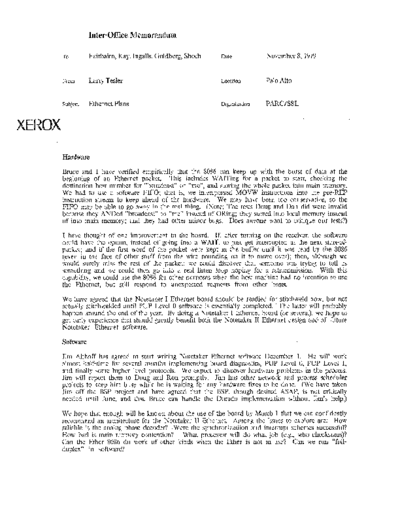Service Manuals, User Guides, Schematic Diagrams or docs for : xerox notetaker memos 19791108_Ethernet_Plans
<< Back | HomeMost service manuals and schematics are PDF files, so You will need Adobre Acrobat Reader to view : Acrobat Download Some of the files are DjVu format. Readers and resources available here : DjVu Resources
For the compressed files, most common are zip and rar. Please, extract files with Your favorite compression software ( WinZip, WinRAR ... ) before viewing. If a document has multiple parts, You should download all, before extracting.
Good luck. Repair on Your own risk. Make sure You know what You are doing.
Image preview - the first page of the document

>> Download 19791108_Ethernet_Plans documenatation <<
Text preview - extract from the document
Inter-Office Memorandum
To Fairbairn, Kay, Ingalls, Goldberg, Shoch Date November 8, 1979
From Larry Tesler Location Palo Alto
Subject Ethernet Plans Organization PARC/SSL
XEROX
Hardware
Bruce and I have verified empirically that the 8086 can keep up with the burst of data at the
beginning of an Ethernet packet. This includes WAITing for a packet to start, checking the
destination host number for "broadcast" or "me", and storing the whole packet into main memory.
\Ve had to use a software FIFO; that is, we interspersed ~AOVW instructions into the pre-REP
instruction stream to keep ahead of the hardware. We may have been too conservative, so the
FIFO may be able to go away in the real thing. (Note: The tests Doug and Dan did were invalid
because they ANDed "broadcast" to "me" instead of ~Ring; they stored into local memory instead
of into main memory; and they had other minor bugs. Does anyone want to 'critique our tests?)
I have thought of one improvement to the board. If, after turning on the receiver, the software
could have the option, instead of going into a WAIT, to just get interrupted at the next start-of-
packet; and if the first word of the packet were kept in the buffer until it was read by the 8086
(even in the face of other stuff from the wire pounding on it to move over); then, although we
would surely miss the rest of the packet; we could discover that someone was trying to tell us
something and we could then go into a real listen loop hoping for a retransmissioll. \Vith t..~is
capability, we could use the 8086 for other purposes when the host machine had no intention to use
the Ethernet, but still respond to unexpected requests from other hosts.
\Ve have agreed that the Notetaker I Ethernet board should be readied for stitchweld now, but not
actually stitchwelded until PUP Level 0 software is essentially completed. 'The latter will probably
happen around the end of the year. By doing a N otetaker I Ethernet board (or several), we hope to
get early experience that should greatly benefit both the Notetaker II Ethernet design and all future
Notctaker Ethernet software.
Software
Jim Althoff has agreed to start writing Notetaker Ethernet software December 1. He will work
almost half-time for several months implementing board diagnostics, PUP Level 0, PUP Levell,
and finally some higher level protocols. We expect to discover hardware problems in the proccss.
Jim will report them to Doug and Ron promptly. Jim has other network and process scheduler
projects to keep him busy while he is waiting for any hardware fixes to be done. (W c have takcn
Jim off the BSP project and have agreed that the BSP, though desired ASAP, is not critically
needcd until June, and that Bruce can handle the Dorado implementation without Jim's help.)
We hope that enough will be known about the use of the board by March 1 that we can confidently
recommend an architecturc for the Notetaker II Ethernet Among the issues to explore are: How
rcliable is the analog phase decoder? ,\Vere the synchronizatiion and interrupt schemes successful?
How bad is main memory contention? What processor will do what job (e.g., who checksums)?
Can the Ether 8086 do work of other kinds when the Ether is not in use? Can we run "full-
duplex" in software?
◦ Jabse Service Manual Search 2024 ◦ Jabse Pravopis ◦ onTap.bg ◦ Other service manual resources online : Fixya ◦ eServiceinfo